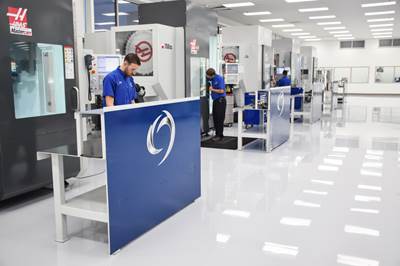When a Magazine Editor Visits Your Shop
Here’s a brief overview of what to expect and how to prepare for a visit to your machine shop from a member of the media such as myself.

I’m commonly asked how we identify shops to profile in Production Machining and have covered that topic in a previous Chasing Threads column. Folks are also curious to know what an editor’s shop visit entails. So, in case you think you might have a good story for us to tell, here’s a bit of “inside baseball” about that.
Early on in the story production process, a writing editor like myself will have preliminary discussions with your shop to identify an article slant or “hook.” The next step is hosting an editor at your facility.
But what do these visits look like? What should you expect? How should you prepare? And, finally, how can you maximize the value of the positive exposure an article with possible video will generate for your company?
Each writing editor handles these visits differently. But, as a general rule, our visits typically last 2 to 3 hours. These involve further discussions with those who have been closely involved with what the story will cover as well as a tour of the facility to photograph and possibly take video of the technology/equipment/process being detailed in the story. This includes, when appropriate, discussions with people such as machine operators, programmers or setup personnel who work where the “rubber meets the manufacturing road” and might have keen insight to provide.
While we can’t sign nondisclosure agreements, we are happy to work with your shop so that proprietary information or images you would prefer not to be used are omitted from the story. Ultimately, you will get a chance to perform a fact-check of the article with photos and video prior to the story being published, so that’s not really an issue.
In terms of photos and video, remember that this is an opportunity to highlight your shop to the world, so consider workplace cleanliness. We hope you already run a tidy, organized operation. But, prior to the visit, take a look around your shop as what you’ll see could be captured in photos or video. And, if you provide company-branded apparel to your employees, suggest that they wear that clothing on the day of the visit.
The photos an editor might take to accompany an article depend on the topic. In general, this could include shots of your overall facility, specific machines, tooling, workholding, workpieces and more. We won’t ask you to shut down a machine to get a photo of its workzone, for example. But, there might be an opportunity to take photos if a machine is temporarily down for setup or there is a specific time during a machining cycle that would lend itself to pausing the operation to open the machine for photos. Photos of machined parts are preferred, although nondisclosure agreements with customers might prohibit photos of them being taken. We understand that.
But don’t forget about video opportunities your shop could provide. All articles that appear in print also appear on our brand’s website and will be pushed to subscribers via our e-newsletters and social media channels. This could be a situation where an editor is filmed interviewing you and/or your employees. However, short videos that demonstrate a tip, trick or “how-to” process (such as how to use a tool presetter or quick-change workholding system) are welcome, especially as they get attention on social media. We suggest consulting with shopfloor employees ahead of an editor’s visit to identify potential video that could be easily captured. Then, communicate those ideas with the editor so he/she can determine what video topics might be best to present to our readers and video viewers.
Once the story is published, we’ll provide a few extra copies of the issue in which your article appears and the URL to the story as it appears on our website. That way, you can link to it from your website or blog, and perhaps send to your customers. It’s possible that a company could see the story either in print or online and eventually become a new customer. (That has happened.) It’s also possible that the story spurs someone to reach out asking about potential job opportunities.
Finally, we’ll push to the story via our social media channels and we suggest you do the same. Be sure to tag Production Machining so we’re made aware of your post and we can then share, like and more.
All in all, the process is not a heavy lift on your part. If this piques your interest, email me and let’s chat about what type of story we could develop.
Related Content
When a CNC Turn-Mill Doesn’t Turn
A shop in Big Sky Country uses a B-axis multitasking machine to produce complex, prismatic medical parts that require no turning complete from barstock.
Read MoreThe Basics of Rotary Broaching
This broaching process creates a non-round shape on the inside or outside of a part with a broach tool.
Read MoreCraftsman Cribsheet No. 128: Why Do Machinists Say Tenths Instead of Ten Thousandths?
In machinist parlance, a tenth is a tenth of a thousandth, not a tenth of an inch.
Read MoreVideo: Why a Production Machine Shop Started a Baseball Bat Company
A 153-year-old manufacturer of precision, metal pins recently started a side business creating custom wooden baseball bats. The reasoning behind establishing this new company is intriguing, as is how it has helped create a stronger bond with the local community.
Read MoreRead Next
Production Machining Editorial Submission Guidelines
Production Machining covers the manufacture of precision parts in high volumes — commonly referred to as the precision machined parts industry. We welcome articles and illustrations of products and services germane to all aspects of this industry.
Read MoreCreate a Virtual Tour of Your Shop
Open houses and tours are techniques leading CNC machine shops use to market their operations to prospective new customers and new hires. It’s also possible to do this digitally like Roush Yates Manufacturing Solutions has, which is helpful in these strange days of social distancing.
Read MoreThe Story Behind a Machining Background Photo
The photo I added to my LinkedIn page shows the application of nifty CNC technology enabling a turn-mill to machine a complex medical device complete. It certainly seemed appropriate.
Read More






















